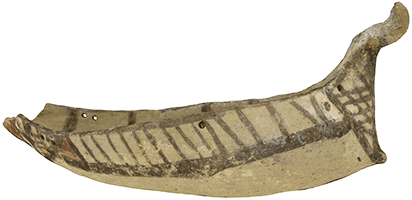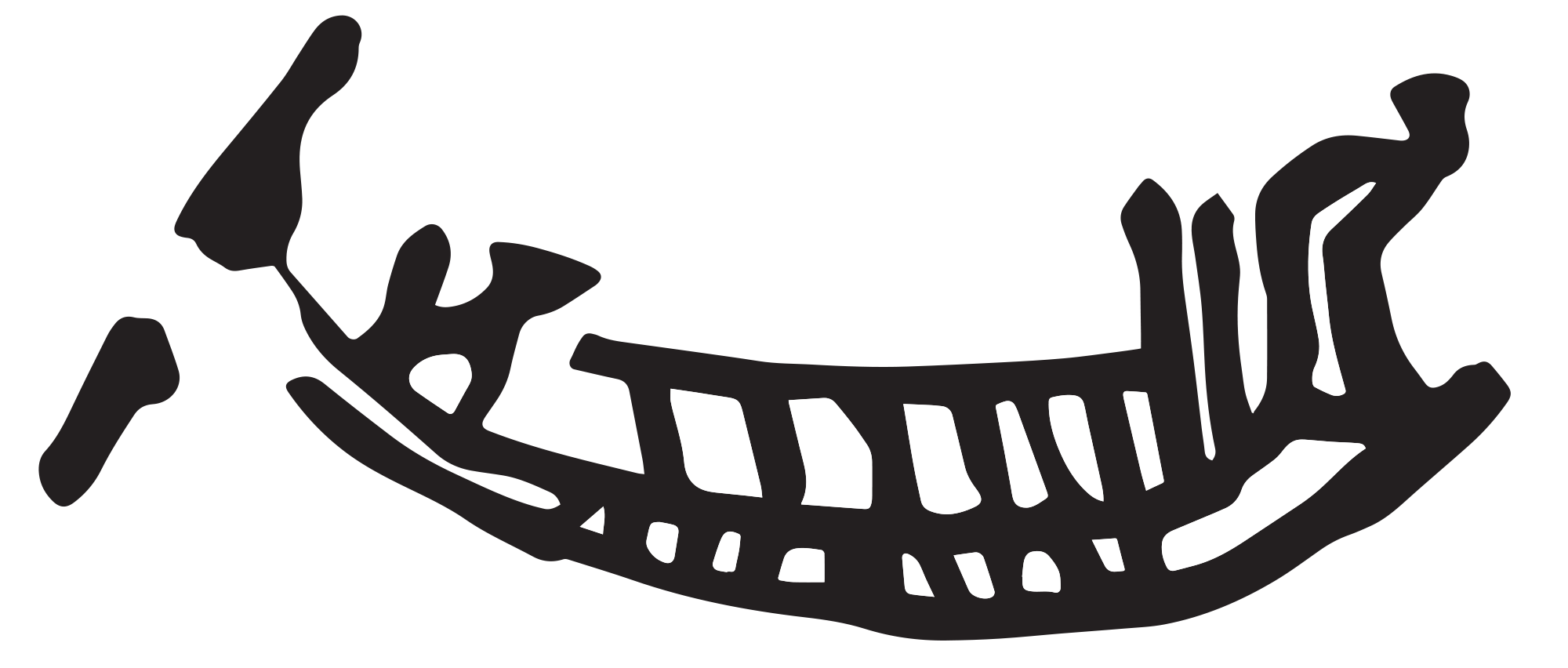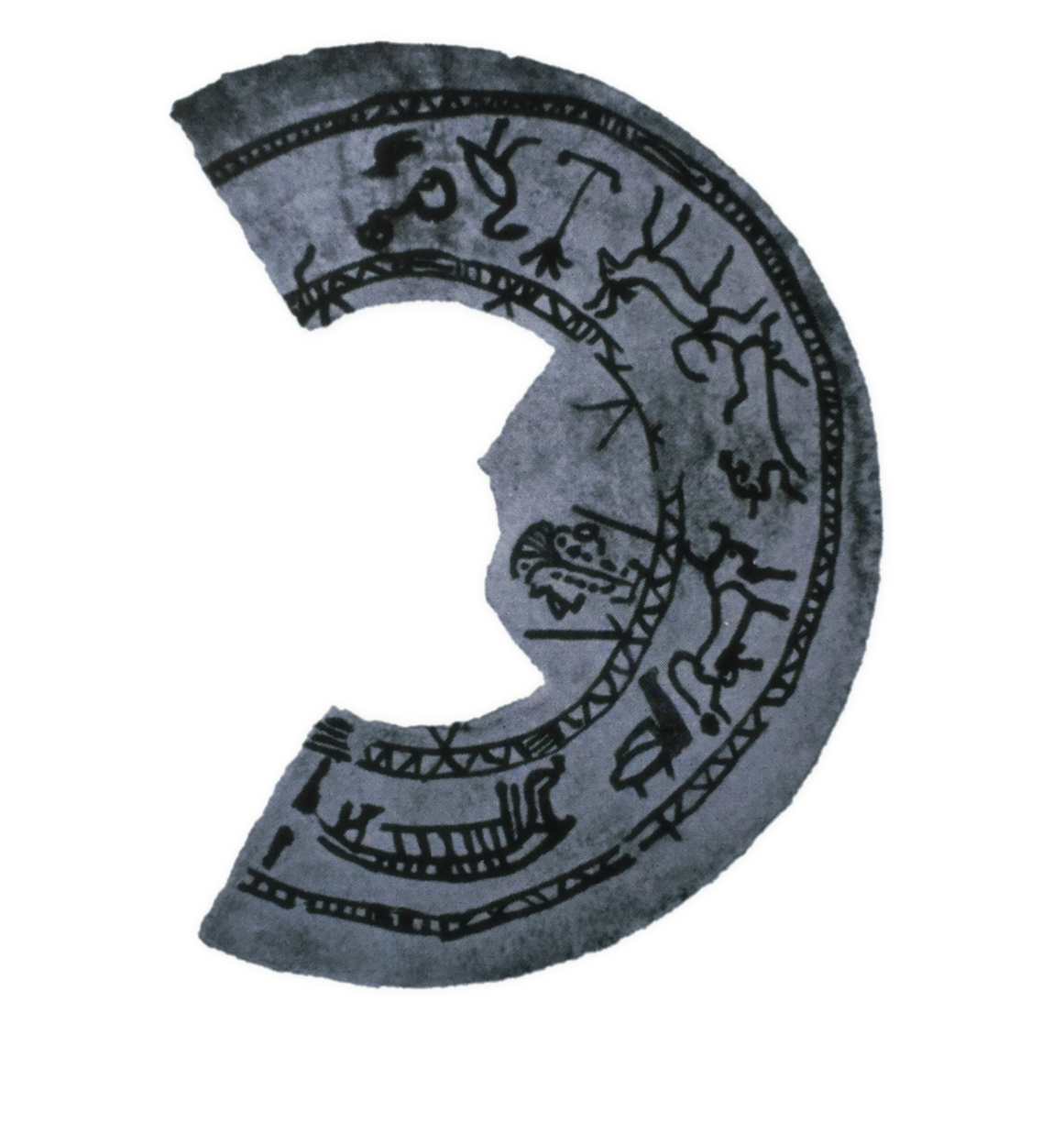Oared ship to the right. Rockered keel line, with a vertical stempost ending in a bird-headed device with an upturned beak. There is a short oblique line across the base of the stempost, possibly a free-standing wale. A short and upcurving bow projection continues the keel line, extending slightly further than the bird-headed device. There are two vertical lines behind the stempost and some sort of structure at the stern that probably indicate the fore- and aftercastle. The vessel is comprised of three curving horizontal lines of similar thickness, with the lowest line A representing the keel line. Line B above it parallels its curvature closely, while uppermost horizontal (line C) is nearly straight. The two upper lines are not evenly spaced, with the area AB being much narrower than BC. Both of these horizontal spaces are intersected by rows of ten and six vertical lines respectively. These are not perfectly aligned and appear to have been painted separately rather than connecting all three horizontals with a single stroke.
Aegean type galley
L24
ca. 1200-1075 B.C. (Hama F early phase, period I of cremation)
Hama
Funerary urn
Ingholt 1940: 69-84, pls. 21-26; Knapp 2019: 125; Wachsmann 1998: 174-76, fig. 9.19a-b; 2013: 59-64, fig. 2.33
Hama is located on the Orontes River in inland Syria. The urn is from period I of Hama's cremation cemeteries located south of the citadel mound, which contained close to 1100 cremation related burial urns. A recent reevaluation of the material has proposed to lower the beginning of Level F from c. 1200 to 1170 BC (Venturi 2007: 38). The excavators originally associated these burials with an intrusive element related to Sea People migrations at the end of the LBA (Hencken 1968: 627). The cremation rite itself is not a reliable indicator, given that the practice is known from nearby Anatolia in the 2nd millennium an from a number of local sites during the LBA such as Alalakh and Tell Sukas(Faivre 2013: 317; Mazzoni 2000: 34-35). Overall, the pottery assemblage of the site is a good representation of Syro-Palestinian ceramic traits and exhibits continuity with the LBA in several respects (Swift 1958: 69). Period 1 of level F did include however European style fibulae and Naue II swords, while the appearance of painted pottery, the use of iron and the practice of cremation are all novelties at the site (Riis 1948: 200; Albright 1951: 106).
The choice of medium as well as the emphasis on showing the rower's gallery does align with Aegean habits. There are however other elements, such as the palms, bulls and antelope which point to influences which are not Aegean. The palm tree motif most notably is a common figural motif in Lebanon, Palestine and Cyprus in the last phases of the LBA and continues into the EIA (Doumet-Serhal 2004). Benson has argued for a close connection between the bird motifs of Hama's F phase pottery and that of Cyprus during LH IIIC (Benson 1975: 132).
The bow projection should be interpreted as a cutwater much like other contemporary galleys. One of the horizontal spaces segmented by verticals must be the open rowers' gallery intersected by stanchions. The upper one possibly equates to a supporting frame for an open bulwark. The wale at the base of the stempost finds a very close parallel in a Cypriot boat model of 11th century date (C19).
Ingholt, H. 1940. Report Préliminaire sur sept Campagnes de Fouilles à Hama en Syrie (1932-1938). Copenhagen: E. Munksgaard.
Knapp, A. B. 2018. Seafaring and Seafarers in the Bronze Age Eastern Mediterranean. Leiden: Sidestone Press.
Wachsmann, S. 1998. Seagoing Ships & Seamanship in the Bronze Age Levant. College Station, TX: Texas A&M University Press.
―――. 2013. The Gurob Ship–Cart Model and Its Mediterranean Context. College Station: Texas A&M University Press.




